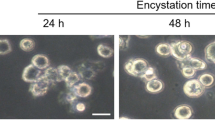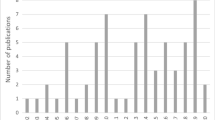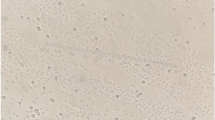Abstract
Species of the genus Acanthamoeba are free-living protozoans that occasionally act as parasites, causing a severe, progressive corneal infection termed Acanthamoeba keratitis (AK). The variable pathogenic potential among Acanthamoeba lineages has been shown by in vitro assays, but little is known about the behavior of different strains in animal models of AK. This work aimed to evaluate the infectivity of Acanthamoeba from distinct morphological groups and genotypes in a rat model of AK and apply an immunohistochemical technique for histological characterization of the lesions. Only a strain classified as group I/genotype T17, isolated from a soil source, caused ulcerated corneal lesions in two Wistar rats (n = 9) subjected to intrastromal inoculation. Two strains derived from AK human cases (group II/genotype T4 and group III/genotype T5) did not induce corneal lesions in the rats. A previous association of group II/genotype T4 trophozoites with lethally irradiated Escherichia coli did not influence the infectivity. A hyperimmune serum produced in Wistar rats was validated by an immunocytochemical technique using the three distinct strains and then applied for immunohistochemistry. The abundance of antigenic residues was observed in both corneas with keratitis, suggesting that the infectious process tended to resolve. Despite the low infection rate of the AK Wistar rat model, we produced an immunochemical tool with a potential diagnostic application. We also showed for the first time the ability of Acanthamoeba from T17 genotype to cause AK in experimental conditions.




Similar content being viewed by others
Data availability
Not applicable
References
Ávila-Blanco ME, Martín-Pérez T, Ventura-Juárez J, Pérez-Serrano J (2020) Experimental keratitis in rats caused by Acanthamoeba griffini: a kinetic histopathological study. Parasite Immunol 42:e12692
Aykur M, Dagci H (2021) Evaluation of molecular characterization and phylogeny for quantification of Acanthamoeba and Naegleria fowleri in various water sources. Turkey Plos One 16:e0256659
Badenoch PR, Johnson AM, Christy PE, Coster DJ (1990) Pathogenicity of Acanthamoeba and a Corynebacterium in the rat cornea. Arch Ophthalmol 108:107–112
Carlesso AM, Mentz MB, da Machado ML, Carvalho A, Nunes TE, Maschio VJ, Rott MB (2014) Characterization of isolates of Acanthamoeba from the nasal mucosa and cutaneous lesions of dogs. Curr Microbiol 68:702–707
Cirelli C, Mesquita EIS, Chagas IAR, Furst C, Possamai CO, Abrahão JS, Dos Santos Silva LK, Grossi MF, Tagliati CA, Costa AO (2020) Extracellular protease profile of Acanthamoeba after prolonged axenic culture and after interaction with MDCK cells. Parasitol Res 119:659–666
Côte MA, Irvine JA, Rao NA (1991) Evaluation of the rabbit as a model of Acanthamoeba keratitis. Rev Infect Dis 13:443–444
Clarke DW, Niederkorn JY (2006) The pathophysiology of Acanthamoeba keratitis. Trends Parasitol 22:175–180
Costa AO, Furst C, Rocha LO, Cirelli C, Cardoso CN, Neiva FS, Possamai CO, Santos DA, Thomaz-Soccol V (2017) Molecular diagnosis of Acanthamoeba keratitis: evaluation in rat model and application in suspected human cases. Parasitol Res 116(4):1339–1344
Dart JKG, Saw VP, Kilvington S (2009) Acanthamoeba keratitis diagnosis and treatment update. Am J Ophthalmol 148:487–499
D’Auria A, Jaime L, Geiseler P, Qvarnstrom Y, Bandea R, Roy SL, Sriram R, Paddock C, Zaki S, Kim G, Visvesvara GS (2012) Cutaneous acanthamoebiasis with CNS involvement post-transplantation: implication for differential diagnosis of skin lesions in immunocompromised patients. J Neuro-Oncol 3:1–7
Diehl MLN, Paes J, Rott MB (2021) Genotype distribution of Acanthamoeba in keratitis: a systematic review. Parasitol Res 120(9):3051–3063
da Rocha-Azevedo B, Costa E Silva-Filho F (2007) Biological characterization of a clinical and an environmental isolate of Acanthamoeba polyphaga: analysis of relevant parameters to decode pathogenicity. Arch Microbiol 188:441–449
Erdem E, Evcil Y, Yagmur M, Eroglu F, Koltas S, Ersoz R (2014) Non-contact lens use-related Acanthamoeba Keratitis in southern Turkey: evaluation of risk factors and clinical features. Eur J Ophthalmol 24:164–172
Feng X, Zheng W, Wang Y, Zhao D, Jiang X, Lv S (2015) A rabbit model of Acanthamoeba keratitis that better reflects the natural human infection. Anat Rec (hoboken) 298:1509–1517
Font RL, Tapert MJ, Robinson NM, Visvesvara GS, Murphy D, Osato MS (1982) An animal model of Acanthamoeba keratitis. Further studies with emphasis on the early phase destruction of the trophozoites. Invest Ophthalmol Vis Sci 22:S163
Garate M, Marchant J, Cubillos I, Cao Z, Khan NA, Panjwani N (2006) In vitro pathogenicity of Acanthamoeba is associated with the expression of the mannose-binding protein. Invest Ophthalmol Vis Sci 47:1056–1062
Garg P, Kalra P, Joseph J (2017) Non-contact lens related Acanthamoeba keratitis. Indian J Ophthalmol 65:1079–1086
Guzmán-Téllez P, Martínez-Castillo M, Flores-Huerta N, Rosales-Morgan G, Pacheco-Yépez J, la Garza M, Serrano-Luna J, Shibayama M (2020) Lectins as virulence factors in Entamoeba histolytica and free-living amoebae. Microbiology 15:919–936
He YG, McCulley JP, Alizadeh H, Pidherney M, Mellon J, Ubelaker JE, Stewart GL, Silvany RE, Niederkorn JY (1992) A pig model of Acanthamoeba keratitis: transmission via contaminated contact lenses. Invest Ophthalmol vis Sci 33:126–133
Koehsler M, Leitsch D, Duchêne M, Nagl M, Walochnik J (2009) Acanthamoeba castellanii: growth on human cell layers reactivates attenuated properties after prolonged axenic culture. FEMS Microbiol Lett 299(2):121–127
Kofman A, Guarner J (2021) Free living amoebic infections: review. J Clin Microbiol 60:e0022821
Larkin DFP, Easty DL (1990) Experimental Acanthamoeba keratitis: I. Preliminary Findings. Br J Ophthalmol 74:551–555
Larkin DFP, Easty DL (1991) Experimental Acanthamoeba keratitis: II Immunohistochernical evaluation. Br J Ophthalmol 75:421–424
Lorenzo-Morales J, Khan NA, Walochnik J (2015) An update on Acanthamoeba keratitis: diagnosis, pathogenesis and treatment. Parasite 22:10
Marciano-Cabral F, Cabral G (2003) Acanthamoeba spp. as agents of disease in humans. Clin Microbiol Rev 16:273–307
Maciver SK, Asif M, Simmen MW, Lorenzo-Morales J (2013) A systematic analysis of Acanthamoeba genotype frequency correlated with source and pathogenicity: T4 is confirmed as a pathogen-rich genotype. Eur J Protistol 49:217–221
Magliano AC, Teixeira MM, Alfieri SC (2012) Revisiting the Acanthamoeba species that form star-shaped cysts (genotypes T7, T8, T9, and T17): characterization of seven new Brazilian environmental isolates and phylogenetic inferences. Parasitology 139:45–52
Mazur T, Hadas E (1994) The effect of the passages of Acanthamoeba strains through mice tissues on their virulence and its biochemical markers. Parasitol Res 80(5):431–434
Niederkorn JY, Alizadeh H, Leher H, McCulley JP (1999) The pathogenesis of Acanthamoeba keratitis. Microbes Infect 1(6):437–443
Page FC (1988) A new key to freshwater and soil Gymnamoebae with instructions for culture. Freshwater Biological Association Scientific Pubhcations, Cumbria, England, p 122
Polat ZA, Ozcelik S, Vural A, Yildiz E, Cetin A (2007) Clinical and histologic evaluations of experimental Acanthamoeba keratitis. Parasitol Res 101:1621–1625
Possamai CO, Loss AC, Costa AO, Falqueto A, Furst C (2018) Acanthamoeba of three morphological groups and distinct genotypes exhibit variable and weakly inter-related physiological properties. Parasitol Res 117:1389–1400
Puech V, Chami M, Lemassu A, Lanéelle MA, Schiffler B, Gounon P, Bayan N, Benz R, Daffé M (2001) Structure of the cell envelope of corynebacteria: importance of the non-covalently bound lipids in the formation of the cell wall permeability barrier and fracture plane. Microbiology 147:1365–1382
Pussard M, Pons R (1977) Morphologies de la paroi kystique et taxonomie du genre Acanthamoeba (Protozoa, Amoebida). Protistologica 13:557–610
Putaporntip C, Kuamsab N, Nuprasert W, Rojrung R, Pattanawong U, Tia T, Yanmanee S, Jongwutiwes S (2021) Analysis of Acanthamoeba genotypes from public freshwater sources in Thailand reveals a new genotype, T23 Acanthamoeba bangkokensis sp. nov. Sci Rep 11:1–13
Ren M, Wu X (2010) Evaluation of three different methods to establish animal models of Acanthamoeba keratitis. Yonsei Med J 51:121–127
Sharma S, Athmanathan S, Ata-Ur-Rasheed M, Garg P, Rao GN (2001) Evaluation of immunoperoxidase staining technique in the of Acanthamoeba Keratitis. Indian J Ophthalmol 49:181–186
Siddiqui R, Khan NA (2012) Biology and pathogenesis of Acanthamoeba. Parasit Vectors 5:6
Van Klink F, Alizadeh H, He Y, Mellon JA, Silvany RE, McCulley JP, Niederkorn JY (1993) The role of contact lenses, trauma and Langerhans cells in a Chinese hamster model of Acanthamoeba keratitis. Investig Ophthalmol vis Sci 34:1937–1944
Veríssimo CDM, Maschio VJ, Correa APF, Brandelli A, Rott MB (2013) Infection in a rat model reactivates attenuated virulence after long-term axenic culture of Acanthamoeba spp. Mem Inst Oswaldo Cruz 108:832–835
Visvesvara GS (2010) Amebic meningoencephalitides and keratitis: challenges in diagnosis and treatment. Curr Opin Infect Dis 23:590–594
Visvesvara GS, Booton GC, Kelley DJ, Fuerst P, Sriram R, Finkelstein A, Garner MM (2007) In vitro culture, serologic and molecular analysis of Acanthamoeba isolated from the liver of a keel-billed toucan (Ramphastos sulfuratus). Vet Parasitol 143:74–78
Walochnik J, Haller-Schober E, Kölli H, Picher O, Obwaller A, Aspöck H (2000) Discrimination between clinically relevant and nonrelevant Acanthamoeba strains isolated from contact lens-wearing keratitis patients in Austria. J Clin Microbiol 38:3932–3936
Wittner M, Rosenbaum RM (1970) Role of bacteria in modifying virulence of Entamoeba histolytica. Am J Trop Med Hyg 19:755–761
Acknowledgements
The authors thank Maria Adelaide Fernandes for providing technical support to care for and breed the animals.
Funding
This work was supported by grants from the Fundação de Amparo à Pesquisa do Estado de Minas Gerais-FAPEMIG, APQ-01100–14.
Author information
Authors and Affiliations
Contributions
Adriana Oliveira Costa, Marcelo Vidigal Caliari, and Cinthia Furst conceived and designed the study, contributed to the data analysis, and supervised the experiments and manuscript writing. Norberto de Souza Fernandes planned and performed all the experiments and drafted the first version of the manuscript. Fabrício Marcos Silva Oliveira contributed to rat immunization and conducted and interpreted the immunochemical reactions. Alexandre Batista Costa Neto and Isabela Aurora Rodrigues contributed to animal manipulation, corneal inoculation, and figure formatting. All authors read and approved the final version of this manuscript.
Corresponding author
Ethics declarations
Ethics approval
All procedures were conducted under accepted guidelines for the care and use of laboratory animals for research and approved by the Animal Experimentation Ethics Committee of the Federal University of Minas Gerais, protocol number 265/2018.
Consent to participate
Not applicable
Consent for publication
All the authors consent to this publication.
Competing interests
The authors declare no competing interests.
Additional information
Section Editor: Sutherland Maciver
Publisher's note
Springer Nature remains neutral with regard to jurisdictional claims in published maps and institutional affiliations.
Rights and permissions
Springer Nature or its licensor (e.g. a society or other partner) holds exclusive rights to this article under a publishing agreement with the author(s) or other rightsholder(s); author self-archiving of the accepted manuscript version of this article is solely governed by the terms of such publishing agreement and applicable law.
About this article
Cite this article
de Souza Fernandes, N., Caliari, M.V., Oliveira, F.M.S. et al. Experimental keratitis induced in rat by Acanthamoeba from distinct morphological groups/genotypes: a histological and immunohistochemical evaluation. Parasitol Res 122, 1167–1175 (2023). https://doi.org/10.1007/s00436-023-07817-3
Received:
Accepted:
Published:
Issue Date:
DOI: https://doi.org/10.1007/s00436-023-07817-3




